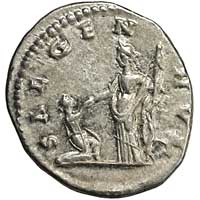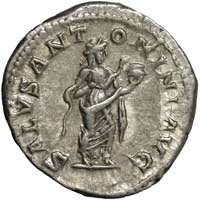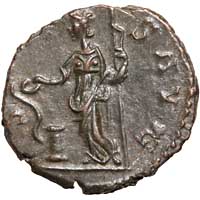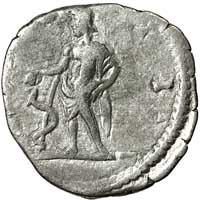| Home Page | Site Map | Useful Links | Email Me | Glossary | Next Page |
| ---------- The Sign Language of Roman Coins ---------- |
| Salus and her Snake |
| You can click on any coin image to see the full coin. |
 A denarius of Mn. Acilius Glabro showing Salus on the obverse, and Valetudo holding a snake on the reverse.
A denarius of Mn. Acilius Glabro showing Salus on the obverse, and Valetudo holding a snake on the reverse.
 alus was a minor goddess, the daughter of Aesculapius, the god of healing, whose staff, with a snake coiled round it, is symbolic of the practice of medicine. Their Greek equivalents were Aklepios and Hygeia. Her role in the pantheon was to feed and care for her father's sacred snakes and act as his assistant. She was worshipped as being responsible for the welfare, not just of individuals, but of the people as a whole. Her name in Greek and Roman comes down to us in such words as 'hygiene,' 'salve' and 'salubrious,' and even 'salute' and 'safe.'
alus was a minor goddess, the daughter of Aesculapius, the god of healing, whose staff, with a snake coiled round it, is symbolic of the practice of medicine. Their Greek equivalents were Aklepios and Hygeia. Her role in the pantheon was to feed and care for her father's sacred snakes and act as his assistant. She was worshipped as being responsible for the welfare, not just of individuals, but of the people as a whole. Her name in Greek and Roman comes down to us in such words as 'hygiene,' 'salve' and 'salubrious,' and even 'salute' and 'safe.'
The coin on the right is a silver denarius of Mn. Acilius Glabrio from 49 BCE. The obverse legend is SALVTIS, so we assume that the bust is of Salus, wearing a wreath, earrings and necklace. On the reverse is a figure labelled VALETV; she is Valetudo, a figure with the same meaning and aspect as Salus. She is holding a sacred snake and apparently gazing into its eyes. Also, she is leaning on a column.
Although she was a minor goddess, at one time Salus had a temple on the Quirinal hill, which was dedicated by the censor C. Junius Bubulcus. Later, during the Empire, the Arval Brotherhood (a college of senior priests) used to make annual sacrifices for the welfare of the Emperor, to the Capitoline triad of major deities and also to Salus Publica. There was a statue to Salus in the temple of Concordia, according to Pliny; and she had an annual festival on 30th March.
 ypes of Salus
ypes of Salus
Salus was often shown seated. Here are three variations of that type. On the far left, an eastern denarius of Severus Alexander shows her seated in an ornate throne, her left elbow leaning on its arm. With her right hand she is holding out a patera, a shallow dish used in religious ceremonies, to feed a snake which is coiled round an altar. The snake has reared up high and is dipping its head to the patera. The way Salus leans her elbow on the arm of her throne, and has her legs crossed, indicates that she is confident and at ease; this is also a common position for Securitas.
Next to that, a denarius of Septimius Severus from 210 CE. Salus is in the same position, but this time her hand is open and empty, making a gesture. The snake has turned its head to direct its gaze along with hers. There is no altar; the snake is coiled around the arm of her throne instead.
On the right is a denarius of Macrinus from 217-218 CE. This is like the left-hand coin except that Salus is much more active. She is leaning forward and holding the body of the snake, directing its head to her patera. Perhaps this indicates a desire to demonstrate a more urgent concern for the welfare of the state; Macrinus was, in effect, a usurper, and has reason to be concerned about his position.
Only the outer two coins mention Salus in their legends: SALVS PVBLICA, the welfare of the people, or perhaps the state. The coin on the left is a denarius of Caracalla from 201 CE that shows an even more widespread concern. Salus has a tall staff in her left hand with a snake twined around it; wth her right hand she is raising a smaller female figure. Harold Mattingly, in BMCRE V, says of this type: "The whole human race has found salvation." You can always rely on Mattingly for a romantic quotation.
On the near right, the alarming Elagabalus had a much more immediate concern. In this denarius from 218-219 CE, the legend SALVS ANTONINI AVG refers to the welfare of the dynasty of Antoninians he had adopted himself into, which is probably a pointed comment on the usurper Macrinus, recently departed, who could make no such claim of relationship.
This is the commonest pose for Salus from this time on. She is standing and grasping the wriggling snake firmly under her arm, directing it to the food she holds out on a dish in her other hand. This rather unrealistic pose reminds me of the way young children sometimes try to feed pets as though they were dolls.
To the far right is an antoninianus of Probus from 281 CE, 50 years later. The pose is just the same, but the snake food looks rather like a hamburger. This is an illusion; the antoninianus of Maximianus from 290-291 CE on the left shows quite clearly that the lower layer is the dish, and the upper one – an egg-shaped lump on this coin – is the food.
The last two coins both have the legend SALVS AVG, and refer directly to the welfare of the emperor.
The Maximianus has a particluarly nice Salus. Look how her toes point at you out of the frame, as though she were standing on a log; look at the motion in her drapery, suggesting a slight breeze; and look at that lively snake.
Here are some other depictions of Salus. On the far right is an antoninianus of Philip I from 244-245 CE. This Salus is holding a steering oar in her left hand. This really belongs to Fortuna, and indicates her role in guiding the emperor through a healthy life. It also hints that mastery of the sea was essential to the welfare of Rome.
Next to it, a denarius of Caracalla from 212 CE. The cornucopia she carries is for the abundance of good things that come from her.
On the far left is an unusual depiction of Salus on a denarius of Nerva from 96 CE. Salus is holding what appears to be a bunch of grain ears. This, together with the SALVS PVBLICA legend, might be taken to indicate that the corn supply was integral to the welfare of the city.
Next to it is an antoninianus of Victorinus from 270-271 CE. On this coin, a rather elegant Salus is standing to feed her sketchily drawn snake which is rising from an altar. She is holding a tall sceptre.
The art at this time was of quite a different style, allowing for a good deal of stylisation. The snake lacks a head; and look at that extra-long finger placed delicately on the sceptre.
 alus in the Legend
alus in the Legend
There are a number of coins that refer to Salus in the legend, meaning health or welfare as usual, but do not have an image of the goddess and use a different type entirely.
On the far right is an antoninianus of Postumus from 260 CE that shows the reclining figure of a river-god, in this case representing The Rhine, with the outline of a Rhine river-boat to one side.
Command of the Rhine was critical to the welfare of Postumus' breakaway Gaulish version of the Roman empire, and the legend, SALVS PROVINCIARVM, reflects that. Postumus was making clear that he had safeguarded the border of his empire along the Rhine. As usual with this issue, the coin is light-weight and with a weak reverse
To its left is an as of Domitian from 85 CE. This shows the facade of the altar enclosure of the Ara Salutis Augusti, an altar for the emperor's health and safety, with the legend SALVTI AVGVSTI. A similar coin was struck for Tiberius.
On the left is an antoninianus of Claudius II Gothicus from 269-270 CE. As well as the more normal Salus type, he struck this coin on which he invokes the aid of the goddess Isis with the legend SALVS AVG. Isis is carrying her situla, a ceremonial water container; and her sistrum, a sort of harsh metallic rattle used by her priests in their ceremonies.
The two coins on the right show the link the god Apollo had with health and well-being. His laurel branch had purifying properties, and was probably here being used to sweep, or perhaps to sprinkle water.
The first coin is of Gallienus, and shows Apollo with a tripod. The second, from Claudius II Gothicus, has his hand resting on a large lyre, of the type known as a cithara. The laurel, the oracular tripod and the lyre were all typical attributes of Apollo.
 rigins of Salus
rigins of Salus
Salus, of course, had a Greek origin as the almost identical figure of Hygieia. On this bronze coin from the Roman colony of Deultum in Greece, Hygieia is facing her father Asklepios.
She is feeding her snake as on the coins shown above, and her father's snake is wound around the famous staff he is holding. The legend is an abbreviation of the name of the colony, Colonia Flavia Pacensis Deultum.
When depicting Hygieia and Salus, Roman snakes have strong wriggly tails, Greek snakes have limp tails. I won't even try to explain that one!
I really like this coin, both for its subject matter and for the delicacy with which it has been executed. This fond look between a father and daughter is quite subtle on such a small scale – Hygieia's head is only 2mm from crown to chin. It is much more realistic and artistic than coins from Roman mints, and it's amazing that it has survived so well over the last 1788 years.
Most coins with this theme are much more damaged or worn. The surface patina on this one is not very tough. On parts of this coin you can see scratch marks where it has been cleaned roughly, and I wouldn't like to try picking the sand grains out of Asklepios' moustache.
Asklepios was well represented on Greek coins, especially from Pergamon, which was a famous centre for his worship. The small bronze coin on the left has his bust on one side and his staff and snake on the other, and needed no other text to show its origin.
In fact, it is possible that this particular item was some sort of temple token, and not a true coin.
Aesculapius (the Roman spelling) appeared on only a few Imperial coins, like this denarius of Clodius Albinus below left. Here he is offering some food to the snake that twines around his staff. There is a British interest here. Albinus was Governor of Britain when the old emperor, Pertinax, died, and was declared emperor there in 193 CE.
In theory, Clodius Albinus was working in partnership with Septimius Severus, who had made him a Caesar, supposedly setting him up for the succession.
But in reality, Severus always wanted his sons to follow him, so he came after Albinus once he had dealt with Pescennius Niger in the east, and ended the potential for rivalry in Lyons in 197 CE, where Albinus committed suicide after losing a decisive battle.
Many depictions of snakes on ancient coins shows them with a horned head (or perhaps with ears), like the one on the Clodius Albinus coin. There are several on my Monsters on Ancient Coins page.
The denarius of Caracalla in the centre, from 215 CE, shows a more realistic snake. This is a more static pose with a snake wreathed around Aesculapius' staff, but not being fed.
On the right is a coin that could have been in the previous section, with its SALVS AVG legend. It is the same depiction of Aesculapius on an antoninianus of Gallienus from 265 CE. The strike of this coin is rather soft; his staff is in his left hand this time.
 arbarous Salus
arbarous Salus
Here is an interesting barbarous Salus. In the 4th century, many small bronze coins were made locally in unofficial mints in the west, either as outright fakes or possibly to have something to act as small change in the absence of a supply of official Imperial bronze coins. Salus was often chosen as a type for these coins, perhaps because she was very recognisable.
The obverse of this coin does not quite look like any emperor, but is probably intended to be Tetricus I. On the reverse is a sketchy drawing of Salus using the same imagery as the Valetudo coin above – though the column looks more like a shooting stick. But this snake is wriggling in a particularly lively way and there's no eye contact.
Something like this reverse with its column also appears on coins of Postumus.
 few more Salus coins
few more Salus coins
Finally, a few more Salus coins showing some more of the stylistic and legend variations.
1. A denarius of Commodus from 188 CE with a rather crude Salus who has been squashed into only part of the available space for no obvious reason. The legend shows the Emperor's titles.
2. A rather nice denarius of Faustina Junior from 161-175 CE with Salus and her throne shown in three-quarter view and the simple legend SALVS.
3. A copper as of Faustina Junior from 161-175 CE with Salus' elbow stuck out over the back of her throne, still trying hard to look casual. SALVTI AVGVSTAE S C.
4. A denarius of Septimius Severus from 197-198 CE with a small flan on which the first part of the legend SALVTI AVGG had been somewhat compressed by the need to find room for the horned snake.
5. An antoninianus of Salonina from 265 CE which is not particularly special except that it looks rather nice and has a vigorously wriggling snake.
6. A contemporary fake of a denarius of Caracalla, after 209 CE, showing Salus seated and feeding a snake which is rising from her knee.
The content of this page was last updated on 14 March 2010
| Home Page | Site Map | Useful Links | Email Me | Glossary | Next Page |




























